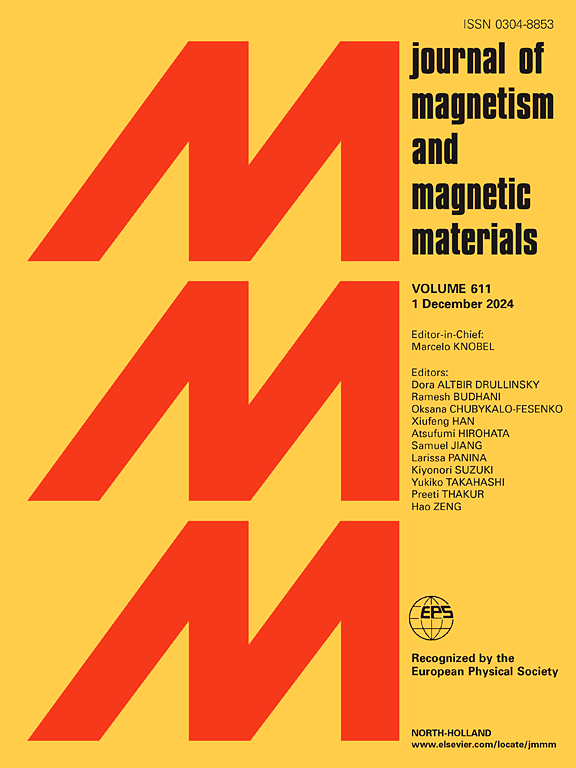激光粉末床熔合制备高矫顽力无重钕铁硼磁体
IF 2.5
3区 材料科学
Q3 MATERIALS SCIENCE, MULTIDISCIPLINARY
引用次数: 0
摘要
采用激光粉末床熔合(LPBF)技术制备了不含重稀土(Dy和Tb)的钕铁硼永磁体。样品的相对密度高达97%,磁性能Br = 0.667 T, HcJ = 1173 kA。(BH)max = 59.4 kJ.m−3。经过充分退火后,磁性能大幅度提高,Br = 0.691 T, HcJ = 1443 kA。(BH)max = 77.9 kJ。得到M−3。这些磁体是使用内部实验线制造的特定粉末制作的,允许根据需要调整尺寸(在本研究中,采用体积D50为40 μm的窄分布粉末)和材料的化学成分。对印刷磁体的微观结构进行了研究,结果表明,印刷磁体主要由无织构的亚微米磁性Nd2Fe14B晶粒组成,晶粒间含有富nd相,与标准烧结磁体的相相同,但平均晶粒尺寸要小几倍。由于富nd晶间相的存在,得到的本禀矫顽力明显高于用商用MQP-S粉末进行LPBF研究的文献报道。在Nd2Fe14B晶粒中经常观察到纳米级的富nd氧化物包裹体。结果表明,在凝固过程中,这些富nd氧化物包裹体可以作为Nd2Fe14B晶粒的核剂。本文章由计算机程序翻译,如有差异,请以英文原文为准。
High–coercivity HRE–free NdFeB magnets by laser powder bed fusion
Additively manufactured NdFeB permanent magnets with no Heavy Rare Earth (HRE) such as Dy and Tb were fabricated by Laser Powder Bed Fusion (LPBF). As-built samples exhibited relative densities up to 97 % and magnetic properties up to Br = 0.667 T, HcJ = 1173 kA.m−1 and (BH)max = 59.4 kJ.m−3. After an adequate annealing, a substantial increase of the magnetic properties up to Br = 0.691 T, HcJ = 1443 kA.m−1 and (BH)max = 77.9 kJ.m−3 was achieved. These magnets have been elaborated using a specific powder fabricated with an in-house experimental pilot line allowing the possibility to adapt both the size (in the case of this study a narrowly-distributed powder with a volumetric D50 of 40 μm) and the chemical composition of the material as desired. The microstructure of the printed magnets has been investigated and is shown to be mainly constituted of untextured submicronic magnetic Nd2Fe14B grains surrounded by an intergranular Nd–rich phase, the same phases as reported in standard sintered magnets but with an average grain size several times smaller. Due to the presence of the Nd–rich intergranular phase, the obtained intrinsic coercivity is significantly higher than the one reported in studies of the literature working on LPBF with a commercial MQP–S powder. Nanosized Nd-rich oxide inclusions are often observed within the Nd2Fe14B grains. It is suggested that these Nd-rich oxide inclusions could act as nucleants for the Nd2Fe14B grains during the solidification process.
求助全文
通过发布文献求助,成功后即可免费获取论文全文。
去求助
来源期刊

Journal of Magnetism and Magnetic Materials
物理-材料科学:综合
CiteScore
5.30
自引率
11.10%
发文量
1149
审稿时长
59 days
期刊介绍:
The Journal of Magnetism and Magnetic Materials provides an important forum for the disclosure and discussion of original contributions covering the whole spectrum of topics, from basic magnetism to the technology and applications of magnetic materials. The journal encourages greater interaction between the basic and applied sub-disciplines of magnetism with comprehensive review articles, in addition to full-length contributions. In addition, other categories of contributions are welcome, including Critical Focused issues, Current Perspectives and Outreach to the General Public.
Main Categories:
Full-length articles:
Technically original research documents that report results of value to the communities that comprise the journal audience. The link between chemical, structural and microstructural properties on the one hand and magnetic properties on the other hand are encouraged.
In addition to general topics covering all areas of magnetism and magnetic materials, the full-length articles also include three sub-sections, focusing on Nanomagnetism, Spintronics and Applications.
The sub-section on Nanomagnetism contains articles on magnetic nanoparticles, nanowires, thin films, 2D materials and other nanoscale magnetic materials and their applications.
The sub-section on Spintronics contains articles on magnetoresistance, magnetoimpedance, magneto-optical phenomena, Micro-Electro-Mechanical Systems (MEMS), and other topics related to spin current control and magneto-transport phenomena. The sub-section on Applications display papers that focus on applications of magnetic materials. The applications need to show a connection to magnetism.
Review articles:
Review articles organize, clarify, and summarize existing major works in the areas covered by the Journal and provide comprehensive citations to the full spectrum of relevant literature.
 求助内容:
求助内容: 应助结果提醒方式:
应助结果提醒方式:


